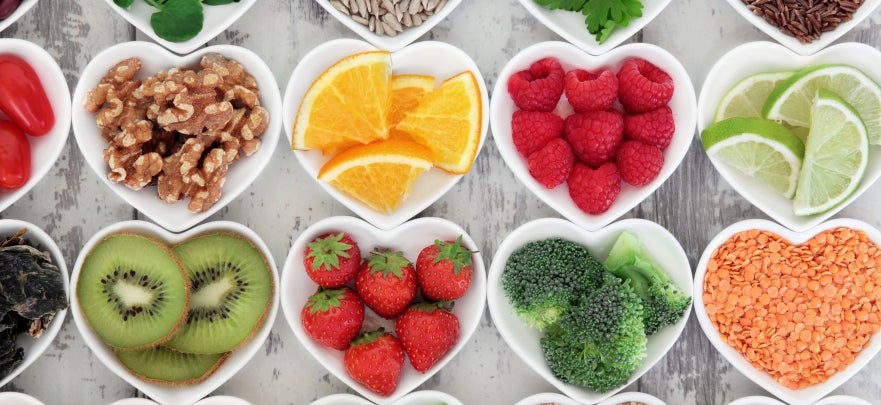Eating Smart for your Heart
Knowing which foods to eat more of and which foods to limit is a powerful way to prevent heart disease and improve your overall health. Use the steps below to work toward a more heart-healthy diet. Here are 6 easy ways to eat smart for your heart.
1. Eat the rainbow
-
Dark-green leafy vegetables. Natural sources of fiber and antioxidants, such as spinach, kale, lettuce, Swiss chard, collard greens, arugula and broccoli, also help the body break down homocysteine, an amino acid that’s linked to a higher risk of cardiovascular disease..
-
Purple Try adding eggplant, beets, purple potatoes or cauliflower to your menu, it’s a fun way to incorporate more color and vegetables onto your plate.
-
Red, Orange Yellow Vegetables are high in beta-carotene, an important antioxidant that helps fight oxidation, which leads to damage in the blood vessels. Include more foods like butternut squash, red and yellow peppers, and carrots.
2. Eat healthy fats & Avoid bad fats
These include fatty fish, coconut, avocado, olive oil, and nuts, such as walnuts. Eating just 5 ounces of nuts per week is linked to decreased cardiovascular disease. Bonus points: Walnuts have more omega-3 fatty acids (which reduce bad cholesterol levels) than other nuts. Avoid trans fats altogether. Watch for the words “partially hydrogenated oils or hydrogenated” on food labels and skip those foods. Also, avoid eating fried foods which are cooked in very unhealthy vegetable oils.
3. Be selective of carbs
Carbohydrates include all the sugars, as well as fiber and starches. Some carbs are better for you than others. For example, fiber is associated with improved digestion and overall health, whereas table sugar provides a lot of calories but no nutritional value! However, sugary carbs can also be in vegetables such as squash and sweet potatoes. In this case, carbs come with many other nutrients and you get energy plus nutrition. In contrast, processed food such as salty snacks and white bread contain a lot of carbs (depending on how much you eat, more than you probably even need!). Limit the amount of carbs you get from these sources to help control your weight.
4. Eat lean protein sources and reduce fatty meats
Lean proteins feed your body without providing unhealthy fats—which means thinking beyond steak. So limit red meat to lean cuts and serve it in smaller-sized portions. Instead, try fish like salmon, trout and tuna, which contain omega-3 fats, which help lower triglyceride levels and may lower blood pressure. Beans such as white, black, kidney beans, etc. provide important fiber as well as protein.
5. Watch what you drink
Water is a necessity for the body. Unfortunately, we often mix this important necessity with things we don’t need, such as large amounts of sugar. When mixed in water, it is easy to consume large quantities of it without even realzing it! Beware of these beverages and try ry to avoid these or only drink in small quantities:
-
Soda pop. A typical 12-ounce can of soda has 150 calories and about 9 teaspoons of sugar. The Dietary Guidelines for Americans call for no more than 12 teaspoons of sugar per day from any source.
-
Alcohol. The recommended amount of alcohol is one drink per day for a woman, or two drinks for a man. Alcohol is known to have many adverse effects, including toxicity to the heart!
-
Juice and other sugary drinks. Along with soda, fruit juice account for much of the excess sugar Americans consume.
6. Reduce portion sizes
How much you eat is just as important as what you eat. Eating until you feel stuffed can lead to eating more calories; putting strain on your heart and blood vessels. Try these sneaky tips:
-
Instead of a large plate, use a small plate or side bowl to help control your portion sizes.
-
Restaurants often serve monster size portions, so ask for a box right away, cut your meal in half and box the extra portion for leftovers.
-
Try to fill up on fresh fruits and vegetables first so you won’t have as much room to eat the unhealthy stuff.
-
Learn your serving sizes. Did you know: one serving of pasta is about 1/3 to 1/2 cup, or about the size of a hockey puck. A serving of meat, fish or chicken is about 4-6 ounces, or about the size and thickness of a deck of cards. Knowing proper serving sizes is a learned skill so you may need to practice with measuring cups or a scale in the beginning until you're comfortable.






